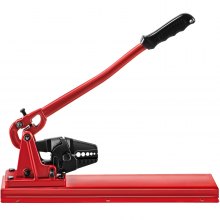












VEVOR, over time, has been able to transcend the primary functionality of its products. Listening to the market and taking advantage of collaborative efforts, VEVOR continues to make high-versatile and essential products like the battery cable crimping tool.
Battery cable crimping tools serve as indispensable tools in securing electrical connections. In addition to this basic function, they further enhance operational efficiency and ensure workplace safety. By facilitating swift and precise crimps, VEVOR's tools streamline assembly processes, reducing downtime and optimizing productivity.
As such, they have found themselves in diverse applications, including automotive repairs, marine, industrial equipment, and emergency power systems.
Battery cable crimping works on a relatively simple principle: a metal sleeve, usually made of copper or aluminum, pushes around the conductor to form a strong electrical connection. This process, known as crimping, synchronizes the electrical current with the device, preventing the wire from bending or fraying over time.
Before crimping, the conductor (usually wire) is prepped for termination or connection. At the end of the wire, the insulation is removed, leaving the conductor naked. The terminal or connector is also cleaned, ensuring that it is clean and there is nothing that could interfere with the integrity of the connection.
The metal sleeve of the terminal is then pressed around the conductor with a crimping tool. This is usually done by pressing the tool handles together, activating a mechanism that applies pressure to the metal fingers. The amount of pressure applied is important, as it determines the shape of the crimp. Too low a pressure can cause a loose connection, while too much pressure can damage a wire or terminal.
After crimping, it is important to examine the assembly for quality standards. This includes checking for proper wiring, as well as checking for signs of damage, irregularities, or crimped areas. Some grinding machines may have fixtures such as window probes or ratcheting devices to assist in this process.
The tapped connection can be tested to verify electrical input and mechanical strength. Continuous testing will be carried out to ensure the integrity of this electrical circuit, and mechanical pressure can be applied to the connection to ensure its durability
Battery cable crimping tools have taken over the market. However, not everyone knows why. You should get one for any of these purposes.
By compressing the metal sleeve of a terminal around the conductor, battery cable crimping tools make a tight and durable connection that minimizes the risk of loosening or disconnection, even in high-vibration environments.
Crimped connections are not only electrically conductive but also mechanically strong. The compression of the metal sleeve around the conductor forms a strong bond that can tolerate tension, bending, and other mechanical loads while maintaining the connection's integrity.
Properly crimped connections provide good electrical conductivity, allowing electricity to flow freely and quickly between components. This is critical in many industries, including automotive, marine, and aerospace, where electrical systems must operate reliably in extreme circumstances.
Crimping is not an easy process. You can make costly errors if you do not pay attention to these possible mistakes. Here are some crimping issues and how you can easily resolve them.
If you notice poor electrical conductivity and mechanical instability from an incompletely compressed conductor, here are the steps to take:
If the crimped metal is deformed or the wire is damaged because you applied excessive force during the crimping process, here are things you should do:
An improperly aligned wire within the terminal before crimping can cause uneven crimps and poor contact between the wire and terminals. Here are some things you should do:
VEVOR is well-known for its devotion to precise engineering, which ensures that its crimping tools meet the highest quality and reliability requirements. VEVOR's crimping tools provide cutting-edge technologies that improve performance and user experience. Ergonomic features that reduce operator strain to built-in inspection windows and ratcheting systems that assure perfect crimping
VEVOR's crimping tools are designed to last, with tough construction and materials that can resist the demands of regular usage. Despite its high quality and innovative functionality, VEVOR's crimping tools are reasonably priced, providing exceptional value for money.
The primary purpose of battery cable crimping tools is to crimp battery cables and terminals. However, they may also be used for other functions, including clamping connectors, lugs, and splices, based on their capabilities and requirements.
The intricacy of battery cable crimping equipment varies, but with appropriate instruction and practice, most are rather simple to operate. Some tools may include customizable settings or capabilities that require familiarization, although they are generally meant to be user-friendly.
Yes, battery cable crimping equipment can fit a variety of connections and wire diameters. However, be certain that the tool and terminals suit the wire size and type you're dealing with.